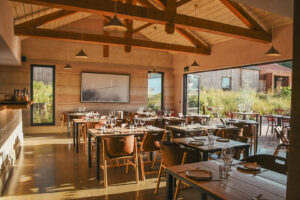
Restaurant Supervisor
Knepp Wilding Kitchen- Restaurant Supervisor Job Description We are looking for a dynamic, enthusiastic and experienced front-of-house professional looking for a new challenge and to
Last guaranteed pre-Christmas order date for Butchery and Gift items: 16th Dec. Dismiss
Skip to contentHome / April: Pergolas and the Great Peat Scandal

Moy Fierheller | Deputy Head Gardener
Published May 2025
Visit Knepp’s rewilded Walled Garden
The sky is swimming pool–blue and days of rainless sunshine quell our fears of a repeat of last year’s dreary wet and cold spring. The native common gorse (Ulex europeus) that has appeared of its own accord in the Rewilded Garden is ablaze in burnished golden yellow amongst its spiked, deep-green needle-like leaves, the scent of coconut and pineapple surely as heady for the honeybees busy with its nectar as it is for us. The royal-purple nodding flower heads of Pasque flower (Pulsatilla vulgaris), so called because they herald the arrival of Easter in the Christian calendar are everywhere amongst the slopes and ridges of crushed concrete and sand. Last autumns rains and this season’s heat seem to have favoured their increase in numbers. Traditionally the flowers and leaves have been used in herbal medicine for their antioxidant and anti-inflammatory properties – the delicate pale lilac seedheads like some exotic wind-riding jellyfish could certainly be described as a sight for sore eyes.
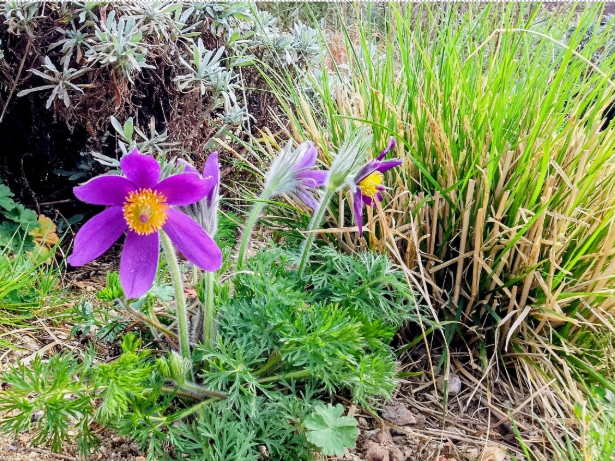
On a particular fresh morning of slanting sunlight, still-standing dark winter stems are illuminated with hundreds of silken webs – the increasing daylight hours and warmth have woken spiders into industrious activity. Another advantage to add to the list of benefits of keeping dead structure right through the winter and beyond. We see the flitting of our first black and red-winged cinnabar moth, orange tip and brimstone butterflies of the year and, of course, the cabbage-white – an ever-present companion to our brassicas in the Kitchen Garden. Despite the grazing of their larvae, Suzi has been harvesting a good crop of purple sprouting broccoli for the house along with baskets of Solomon’s seal (Polygonatum x hybridum) spears, a plentiful and delicious alternative to our later-emerging asparagus.
In the greenhouse the great seasonal change-over begins. Like bustling matrons in a dormitory of sleepy headed children we rouse the over-wintering tender ornamental plants – citrus, orchids, sages and succulents. “Come on, time to wake up! Time to go outside and say hello to the sunshine, the longer days and fresh air!” We make space for the heat-lovers that are outgrowing their seedling pots, tomatoes, aubergines, sweet peppers and chillies. With the help of Knepp’s volunteers we place a series of pudding-bowl mounds of leaf mould all through the two large, roughly square plots of the rhubarb beds outside. Suzi and Charlie attended an Agroforestry Workshop last month with Joshua Sparkes at Birch Farm in Devon and are keen to try and implement some of the elements of his style of edible growing in the garden. Joshua is a proponent of syntropic agroforestry, a food production system that mimics the look and function of a natural forest, and involves planting a diverse range of crops and managing them in a way that promotes mutual support and collaboration among different species. It’s a way of replicating and accelerating natural processes within an ecosystem, and Joshua highlights the crucial role of microbes and beetles in a system where there is no tillage, no chemicals or compost and no weeding – weeds are simply cut and dropped as a living mulch. He uses indigenous microorganisms that he has encouraged and harnessed in various ways to increase soil fertility and health, leaving inoculated heaps at field scale. The leaf mould mounds in our beds are more modest versions of this principle, but the fungal and microbial contribution will hopefully be proportionate to the size of the bed, the mounds helping to retain moisture and networks of microorganisms better than if the leaf mould was spread in a thin layer over the soil.

The issue of what kind of materials we should be using to grow plants in the horticultural industry was in the news again at the beginning of the month when the Royal Horticultural Society (RHS) delayed banning the use of peat-free compost in their annual flower shows for a further two years. The RHS cites lack of legislative guidance from successive governments and lack of funding for viable alternatives and transition. Previously, the government had announced a ban on the sale of peat and products containing peat in the retail horticultural sector by 2024. But in 2023 the complete ban was pushed forward to 2030. The Horticultural Trades Association reported the total quantity of peat used in growing mediums in 2022 was 1,690,000 cubic metres.
Undoubtedly most gardeners (and presumably gardening politicians?) would mourn a world where their green space was bereft of familiar British native insects – a two-spot ladybird, a common blue butterfly, the heavy drone of a buff-tailed bumblebee, or the darting of a large red damselfly over a garden pond in spring. Yet we’re all aware of the climate crisis and the effect of carbon emissions on an increasingly warmer planet, where rising temperatures will severely impact the populations and diversity of insects in this country that we take for granted.
When we talk about peat, we gardeners tend to picture a bag of compost. There is a disconnect in our minds between what peat is and where it comes from. Peat soils are naturally accumulated dead and decaying plant matter in waterlogged conditions. Peatlands cover just 3% of the world’s land mass (across 180 countries) yet hold almost 30% of the world’s soil carbon – more than twice the carbon stored in the world’s forests. In the UK, peatland covers nearly 3 million hectares – an international rugby pitch is around a hectare – and research by the Wildlife Trusts reveals that peat extraction for the horticultural industry has caused up to 31million tons of CO2 to be released since 1990.
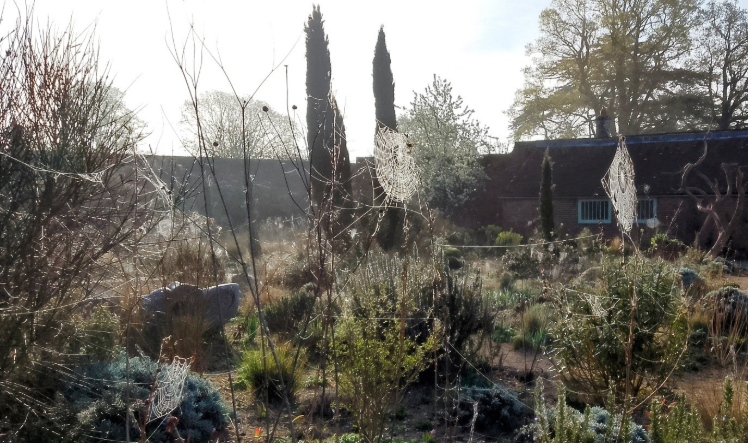
They are the most carbon-rich ecosystems on earth and when they’re degraded by agriculture, excavation for compost and other products, and even just poor management, they become major emitters of carbon. They also act as a filtration system for clean drinking water, mitigate floods by slowing water down, and provide a wildlife habitat that supports a complex web of biodiversity, including many rare or endangered species found only in peatlands. The many layers of peat, established over eons, are a historical, cultural and environmental encyclopaedia.
In the last five years there has been an increase in peatland restoration – although the UK Peatland Strategy is careful to stress that this momentum needs to be maintained. Peatland restoration is one of the most cost-effective solutions for reducing greenhouse gas emissions. At Knepp, we’re deeply disappointed that the government has not legislated against the use of peat for horticulture, and that the horticultural industry itself, especially august bodies like the RHS, haven’t taken the lead on this. Sadly, there are still celebrity gardeners refusing to take the issue of peat extraction seriously.
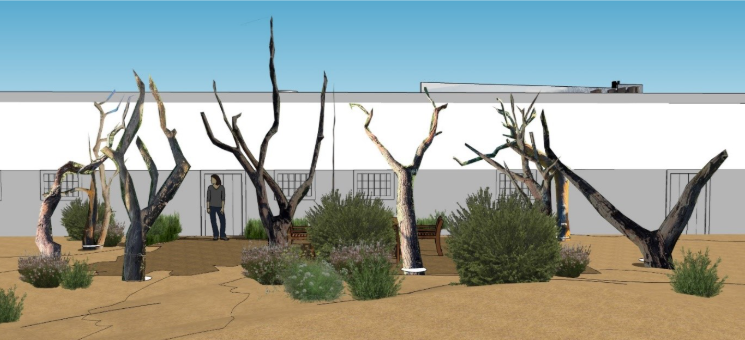
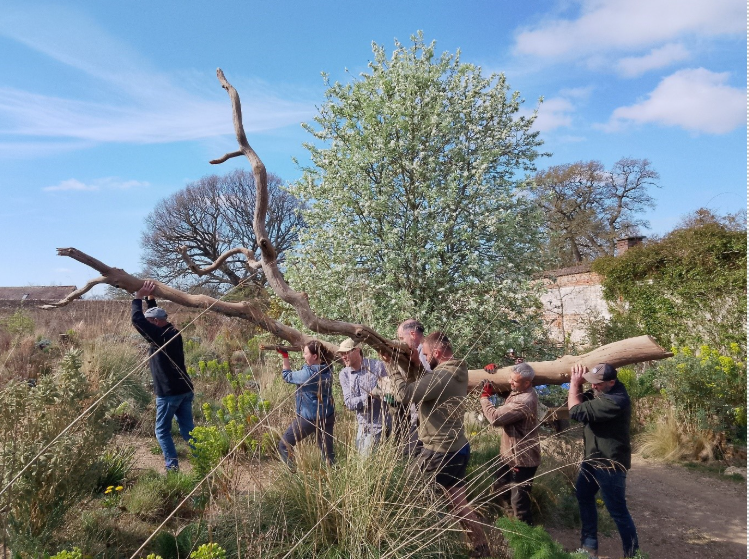
For us gardeners, however, there is life beyond peat. It’s a small step to choose peat-free compost – alternatives are made from renewable sources like coconut fibre (coir), composted bark, wood fibre or green waste made from composted garden and household waste. Mixes cater for moisture retention and nutrient content, sometimes containing composted bracken, wool or manure depending on its ultimate use. Peat-free composts can be added to or mixtures tweaked to suit the plant – discovering their native habitat and mimicking soil conditions by adding sharp sand or mole-hill soil for example can help give a plant the best start. Websites like Enrich the Earth and Garden Organic have a wealth of detailed and helpful information – see below for links.
Meanwhile, on the terrace in front of the Rewilded Garden’s potting shed, we have taken some giant steps forward in a project that has been a few years in the making. There used to be a conventional oak-beam pergola here, supporting several grapevines, but Tom Stuart-Smith, our garden designer, was keen to reduce man-made structures in the garden and had suggested using natural stag oak limbs instead. We’re lucky to have many veteran oaks at Knepp which have begun their slow decline with skeletal limbs projecting from their crowns, like the antlers of deer. Now in its twenty –fifth year, the rewilding project has plenty of dead wood to spare.
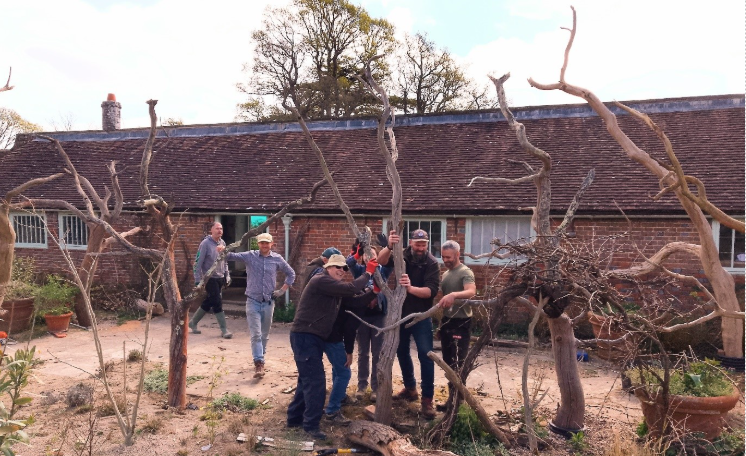
The journey from the top of the tree to the garden for these wonderful sculptural supports has taken many stages. The first job was to find them – Knepp’s 3,500 acres is not a short walk, and the limbs had to be the right size and shape and come from a tree that was accessible for machinery to move and transport it. Since we sit on 320 metres of Wealden clay, using machinery in autumn and winter is impossible – once wet the soil becomes a mess of sludgy porridge, prone to compaction under the weight of heavy machinery, which deprives the soil biota of oxygen. Once the appropriate dead limbs are found, cutting and removing them without damaging the rest of the tree is not an easy feat, not least because of the weight and density of the limbs themselves – a 10-foot oak log weighs between 600 and 800lbs. Luckily, we have some very skilled and knowledgeable rangers and tree wranglers on site that managed this high-wire act of dexterity. Once the chosen limbs had arrived, the last piece in the puzzle was to get them into the garden and standing upright. Most of the paths in the Rewilded Garden are no wider than a wheelbarrow, so machinery wasn’t an option. The Knepp volunteers came to the rescue. Not exactly a case of many hands making light work – it took seven people to move one limb! – but certainly, this problem shared was a problem solved.
The month continues apace, the hedgerows’ bountiful blackthorn blossom gives way to wild apple and the hawthorns’ loaded garlands of white moves to centre stage amidst flurries of snowlike petals. The world is suddenly cloaked in impossibly vibrant spring green and the garden is a daily wonder of species exploding into colour and scent. In these challenging times, look to the garden.
Tips for May from the rewilded Walled Garden team
1. Grazing: Think like a herbivore, and continue a gradual, selective cut back of last year’s dead growth. Vary the heights of cut, still leaving some seedheads and hollow stems to support wildlife and provide architectural interest in decay.
2. Chop and Drop Mulching: Leaving some clippings from the cut back in-situ to feed the soil and detritivores, or bundled up to create habitat for other insects and toads, you can also use this material to mulch vegetable beds to lock in moisture, provide habitat for slug-predators such as beetles, and protect young seedlings.
3. Perennial Veg: Plant out perennial vegetables such as certain varieties of kale, mashua (Tropaeolum tuberosum) and Korean celery (Dystaenia takesimana) grown from seed or tuber. Perennial vegetables can keep providing a crop over multiple years, help to mimic layers of a forest ecosystem, require less work in the long term, and can help diversify our diets too!
4. Moth traps: As the nights warm up, May is a great time to start monitoring the different moths that visit your garden. It’s possible to make your own moth trap, but borrowing or buying one is probably easier! Enjoy recording the different species that you find, and seeing if you can identify the plants in your garden they may be using for food or reproduction.
5. Mowing: Relaxing the mowing of lawns at this time of year can help flowering plants to offer valuable opportunities for wildlife. Mowing paths can help make a lawn look well cared for, as well as mimicking grazing disturbance to create different height swards which might support other forms of wildlife such as ground nesting bees or fungi.
You can visit Knepp’s rewilded Walled Garden
Photos courtesy of Charlie Harpur, Moy Fierheller
What we’re reading:
Agenda Gotsch – Ernst Götsch’s Syntropic Farming Official Website
Agroforestry Workshop – Design, Plant and Establish (sold out) –
Fukuoka, M, The One-Straw Revolution (First Published 1978), NYRB Classics 2009
High prevalence of veterinary drugs in bird’s nests – PubMed
Sale of horticultural peat to be banned in move to protect England’s precious peatlands – GOV.UK
https://www.instagram.com/reel/DHdJIVEK7cZ/?igsh=OHIxdTVsNXo3M3pi
Media reporting on peat-ban for the professional Horticulture sector – Defra in the media
Devastating climate impact of using peat in UK horticulture revealed | The Wildlife Trusts
Choose Peat-Free — Enrich the Earth
Help us stop the use of peat compost in gardens | Garden Organic
List of peat-free nurseries in the UK / RHS
About Peatlands | IUCN UK Peatland Programme

Knepp Wilding Kitchen- Restaurant Supervisor Job Description We are looking for a dynamic, enthusiastic and experienced front-of-house professional looking for a new challenge and to
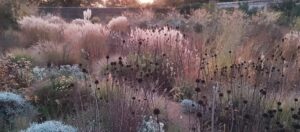
Moy Fierheller | Deputy Head Gardener Published December 2025 Visit Knepp’s rewilded Walled Garden November begins with warmth and rain. The remnants of Hurricane Melissa that caused tragedy and catastrophic

Knepp Wildland PodcastEpisode 43: Headwinds and hope: Tony Juniper on Why Nature Restoration is a path to Economic Growth 2 December 2025 This time we
Knepp Wildland Safaris, our gardens and campsite are all about the quiet and patient observation of nature.
Some of the species we are likely to encounter are shy or can be frightened by loud noises or sudden movements. Our campsite with open-air fire-pits, wood-burning stoves and an on-site pond is unsuitable for small children.
For this reason, our safaris, garden visits, holiday cottages and campsite are suitable only for children of 12 and over.
You’ll receive relevant offers and news by email. This will include information about the Rewilding Project, online store products, the Wilding Kitchen Restaurant / Cafe, and other exciting experiences / events across the Knepp Castle Estate. For more information, view our Privacy Policy.